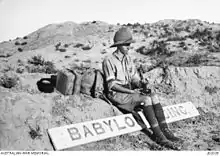Eric Keast Burke
Eric Keast Burke (16 January 1896 – 31 March 1974) was a New Zealand-born photographer and journalist.
Eric Keast Burke | |
|---|---|
 Eric Keast Burke | |
| Born | 16 January 1896 Christchurch, New Zealand |
| Died | 31 March 1974 (aged 78) Concord, New South Wales, Australia |
Early life and education
Burke was born at Christchurch, New Zealand. He was the only child of Walter Ernest Burke, and his wife Amy Eliza Mary, nee Thompson. He went to Sydney with his family in March 1904 and was educated at Sydney Church of England Grammar School and the University of Sydney where he studied economics.[1]
War service
During World War I, after a year in the Signal Corps, Australian Military Forces, he enlisted in the Australian Imperial Force. He embarked for the Middle East in December 1917 and served as a sapper with the 1st Australian Wireless Signal Squadron, Mesopotamian Expeditionary Force.[2] He was discharged on 28 January 1920 on his return to Sydney.[1]
On 23 November 1925 he married Iris Lily Daniell.
During World War II he served as a captain in the Volunteer Defence Corps, and worked in intelligence.[1]
Photography and research
In 1922 he became associate-editor, under his father, of the Australasian Photo-Review.[3] He exhibited his work in Australia, Europe, London and the United States of America, and in 1938 was elected an associate of the Royal Photographic Society of Great Britain for a portfolio of male figure studies. That year he was appointed Australian chairman of Kodak International Salons of Photography.[1]
He edited the Australasian Photo-Review from 1943–1956.
Recognizing the significance of photography to Australian history, in 1943 Burke published a series of articles on early photographers, among them William Jevons, J. W. Lindt and Charles Kerry. His wife, Iris, became his valued research assistant.[1]
In 1952 Burke located the Holtermann Collection of wet-plate negatives and recommended its donation to the Mitchell Library in Sydney;[4] in a shed in Chatswood, New South Wales, glass plates created by Beaufoy Merlin and Charles Bayliss were ranged in 'neat stacks of cedar boxes of various dimensions, each with slotted fittings which held the large negatives in perfect preservation.' The negatives disclosed 'every detail of the lives of our gold-fields pioneers'. He devoted several issues of AP-R to the discovery.
Burke provided his expertise to Jack Cato through regular correspondence as the latter was researching for his The Story of the Camera in Australia, published in 1955.[5][6] In 1956 after the Australasian Photo-Review folded, he was employed as advertising manager for the Kodak Company.[1]
Later life
Having formally retired at 64 in 1960, from 1961 to 1969 Burke was the first editor and then art director of Australian Popular Photography (later named Australian Photography),[7] a contributor to the Australian Dictionary of Biography and a frequent judge of photographic competitions. As consultant in photography to the National Library of Australia, Canberra, he oversaw the preservation of historic photographs. He later published Gold and silver : an album of Hill End and Gulgong photographs from the Holtermann Collection in 1973.[4] Burke lectured on the collection, prepared exhibitions and presented a television series, 'Peeps into the Past with Keast Burke', for the Australian Broadcasting Commission. His other interests included bushwalking, native flora and fauna, genetics, maps and map-making, amateur radio, architecture and engineering.[1]
Eric Keast Burke died on 31 March 1974 in Concord Repatriation General Hospital and was cremated. He was survived by his wife Lilly, a daughter and three sons.[1]
Works
- Burke, Keast; Australian and New Zealand Wireless Signal Squadron History. Committee (1927), With horse and morse in Mesopotamia : the story of Anzacs in Asia, A. & N.Z. Wireless Signal Squadron History. Committee], retrieved 15 July 2014
- Burke, Keast (1932), Achievement : a collection of unusual studies of the Sydney Harbour Bridge, McPherson's Pty. Ltd, retrieved 15 July 2014
- Burke, Keast (1973), Gold and silver : an album of Hill End and Gulgong photographs from the Holtermann Collection, Heinemann, ISBN 978-0-85561-005-0
References
- Australian Dictionary of Biography. Retrieved 6 June 2014.
- National Archives of Australia. Burke's World War I Service Record. Retrieved 6 June 2014.
- Welch, Edwin J (January 1894). "Publisher's Notice". Photographic Review of Reviews (1): 3–4.
- Holtermann, Bernhardt Otto; Burke, Keast, (editor.); Holtermann Collection (1973), Gold and silver : an album of Hill End and Gulgong photographs from the Holtermann Collection, Heinemann, ISBN 978-0-85561-005-0CS1 maint: multiple names: authors list (link) CS1 maint: extra text: authors list (link)
- first in his Acknowledgements, Cato gives prominent credit to Keast Burke, "editor of The Australasian Photo-Review, whose fortnightly letters over a period of four years advised, suggested, and criticised this work as it developed; who generously placed a number of historical items at my disposal, and brought the resources of Kodak (Australia) Pty. Ltd. to my assistance–to him, and to them, my grateful thanks." Cato, Jack (1955), The story of the camera in Australia (1st ed.), Georgian House, p. vii
- Newton, Gael (1986). "A Story of the Story: Correspondence between Jack Cato and Keast Burke. Originally published in Photofile, Autumn 1986". www.photo-web.com.au. Retrieved 30 December 2020.
- Australian Photographic Society; Australian Photographic Federation (1961), Australian popular photography, Photo Publishing Co
External links
- Photo Web. Keast Burke pages. Retrieved 6 June 2014.
- National Library of Australia. Keast Burke Collection. Retrieved 6 June 2014.
- Art Gallery of New South Wales. Works by Keast Burke. Retrieved 6 June 2014.
